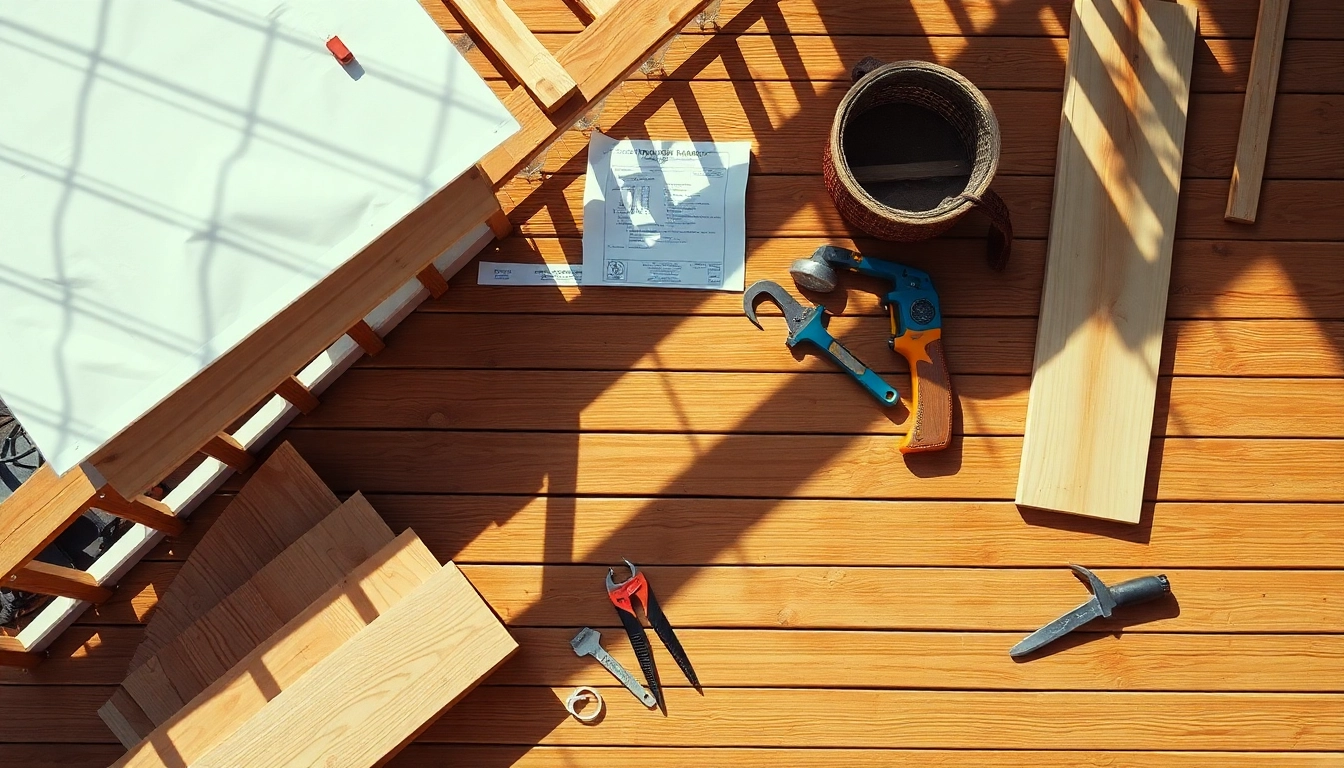Introduction to Deck Construction
Building a deck can enhance the value and enjoyment of your home, offering a space for relaxation, entertainment, and connection with nature. Whether you’re working on your first project or looking to refine your skills, understanding the complexities of deck construction is essential. This comprehensive guide will provide you with in-depth insights into the deck-building process, from planning to execution, including best practices, common mistakes to avoid, and cost considerations.
Understanding the Basics of Deck Building
Deck construction involves creating an outdoor extension of your home that can be used for a variety of purposes, such as entertaining guests or enjoying family cookouts. It’s crucial to grasp a few foundational concepts, such as what constitutes a deck, the structural requirements, and relevant building codes.
A basic deck is comprised of several components, including a frame, decking, and railings. The frame is the skeleton of the deck, supporting the load it must bear. Decks can vary widely in shape, size, and material, with designs that can accommodate anything from simple rectangles to elaborate multi-level compositions.
Common Materials Used in Deck Construction
When it comes to selecting materials for your deck, there are several options available:
- Pressure-Treated Wood: This is the most common material due to its affordability and availability. It’s chemically treated to resist rot and insects.
- Composite Decking: Made from a mixture of wood fibers and plastic, composite materials are durable and often come with warranties, though they tend to be more expensive.
- Cedar and Redwood: These natural woods are attractive and resistant to decay but require regular maintenance to maintain their appearance over time.
- Aluminum: This low-maintenance, lightweight material is resistant to corrosion and can withstand the elements, although it may not provide the same aesthetic warmth as wood.
Planning Your Deck Project Effectively
Proper planning is crucial in ensuring your deck-building project runs smoothly. Begin by considering the following steps:
- Determine Purpose: Define how you plan to use your deck. Will it be for entertaining, dining, gardening, or simply a quiet refuge?
- Check Local Building Codes: Different locales have specific regulations regarding deck construction, including setbacks, height restrictions, and permitted materials.
- Create a Design: Sketch out your ideas and consider factors like shape, elevation, and integration with existing landscaping.
- Budgeting: Establish a clear budget that includes materials, labor, and unexpected costs. Understanding the costs upfront can prevent budget overruns.
Tools Needed for Successful Deck Construction
Essential Hand and Power Tools
A successful deck project requires various tools. Here’s a rundown of the must-haves:
- Measuring Tape: Essential for making accurate cuts and ensuring everything fits properly.
- Level: To ensure your deck is even and stable.
- Drill: Necessary for making holes and driving screws into the deck materials.
- Miter Saw / Circular Saw: Important for making precision cuts on lumber.
- Post Hole Digger: Used for digging deep holes to set posts in the ground.
Safety Equipment for Deck Building
Safety should never be compromised during construction. Ensure to use the following personal protective equipment:
- Safety Goggles: Protects your eyes from wood chips and dust.
- Gloves: To protect your hands from splinters and sharp objects.
- Hard Hat: Essential, especially if working under structures or in areas where tools can drop.
- Ear Protection: When using loud power tools, ear protection is recommended.
Measuring and Layout Tools
To ensure precision and accuracy, proper measuring tools play a significant role in deck construction:
- Chalk Line: Handy for marking straight lines over larger areas.
- Speed Square: Useful for establishing various angles when framing your deck.
- String Line: Great for checking the alignment of your deck’s framing.
Step-by-Step Deck Construction Process
Preparing the Site for Deck Building
Site preparation is a critical step that sets the foundation for successful construction. Here’s how to go about it:
- Clear the Area: Remove any debris, vegetation, or obstacles that could interfere with construction.
- Take Accurate Measurements: Mark out the area where the deck will be built; use stakes and string to outline the perimeter.
- Grading and Leveling: Ensure the surface is level where the deck will sit, considering drainage for water runoff.
Key Structural Components in Deck Construction
The structural integrity of your deck relies heavily on its key components:
- Footings: The base of your deck, these concrete structures support the deck’s weight and need to be installed below the frost line.
- Posts: Vertical supports attached to the footings, crucial for holding up the deck’s framework.
- Beams and Joists: The beams serve as the main support structure, while the joists are the horizontal members that support the decking material.
- Decking: The surface board of the deck that users walk on; choices include wood, composite, or PVC materials.
Final Finishing Touches for a Beautiful Deck
Once the structural components are installed, add finishing touches for both aesthetics and functionality:
- Railings: Safety features that also add to the visual appeal of the deck. Select styles that complement the overall design.
- Staining or Sealing: For wood decks, applying a protective stain or sealant can prevent weather damage and extend their lifespan.
- Deck Lighting: Consider integrating lighting for ambiance and safety.
Deck Construction Techniques and Best Practices
Innovative Design Tips for Your Deck
Enhancing the layout and design of your deck will not only improve its functionality but also its aesthetic appeal:
- Multi-Level Decks: Consider creating levels to add dimension and provide separate areas, such as dining and relaxation spaces.
- Built-In Seating: Integrate benches or planters into the deck structure to maximize space.
- Outdoor Features: Incorporate features such as fire pits, outdoor kitchens, or even water elements for added allure.
Common Mistakes to Avoid in Deck Building
While building a deck can be rewarding, several common pitfalls can lead to frustration:
- Skipping Permits: Always check with your local municipality regarding the need for permits.
- Poor Planning: Inadequate planning can result in significant delays; always draft a complete plan before starting.
- Neglecting Safety Codes: Adhering to building codes ensures the safety and compliance of your structure.
Maintenance Tips for Long-Lasting Decks
Regular maintenance is essential to prolonging the life of your deck:
- Regular Cleaning: Clean your deck to prevent mold and debris build-up.
- Inspect Frequently: Regularly check for signs of damage or wear, particularly after harsh weather conditions.
- Apply Sealants: For wooden decks, consider reapplying sealants annually to maintain protection against the elements.
Cost Considerations for Deck Construction
Estimating Material Costs Accurately
Understanding the costs associated with materials is crucial for budgeting:
- Calculate Square Footage: Measure the total square footage of your planned deck to estimate material quantities accurately.
- Material Prices: Research current prices for materials within your locality, as these can vary significantly.
- Consider Additional Features: Take into account features such as railings, stairs, and built-in furniture, which can increase costs.
Labor Costs and DIY vs. Hiring Professionals
Deciding whether to undertake the project yourself or hire professionals can greatly affect your budget:
- DIY Savings: Taking on the project yourself can save money, but ensure that you have the necessary skills and tools.
- Professional Help: Hiring professionals can expedite the construction process, offer expertise, and ensure compliance with building codes, but will increase costs.
Financing Options for Large Deck Projects
For extensive projects, consider various financing options available:
- Home Equity Loans: A common choice for leveraging home value to finance renovations.
- Personal Loans: Can cover the costs but expect higher interest rates compared to home equity solutions.
- Credit Cards: Depending on the amount, credit cards can be a quick financing option if managed carefully to avoid high interest.


